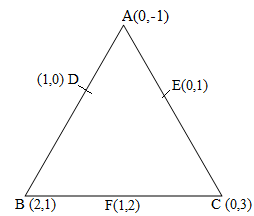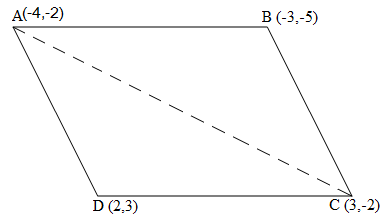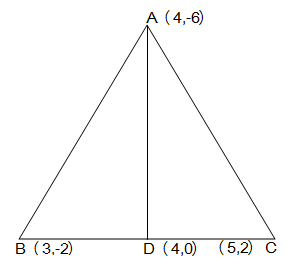NCERT Solutions Class 10 Maths
Chapter – 7 (Coordinate Geometry)
The NCERT Solutions in English Language for Class 10 Mathematics Chapter – 7 Coordinate Geometry Exercise 7.3 has been provided here to help the students in solving the questions from this exercise.
Chapter : 7 Coordinate Geometry
- NCERT Class 10 Maths Solution Ex – 7.1
- NCERT Class 10 Maths Solution Ex – 7.2
- NCERT Class 10 Maths Solution Ex – 7.4
Exercise – 7.3
1. Find the area of the triangle whose vertices are:
(i) (2, 3), (-1, 0), (2, -4)
(ii) (-5, -1), (3, -5), (5, 2)
Solution –
Area of a triangle formula = × [x1(y2 – y3) + x2(y3 – y1) + x3(y1 – y2)]
(i) Here,
x1 = 2, x2 = -1, x3 = 2, y1 = 3, y2 = 0 and y3 = -4
Area of triangle = [2 {0- (-4)} + (-1) {(-4) – (3)} + 2 (3 – 0)]
= {8 + 7 + 6}
= 21/2
So, the area of the triangle is 21/2 square units.
(ii) Here,
x1 = -5, x2 = 3, x3 = 5, y1 = -1, y2 = -5 and y3 = 2
Area of the triangle = [-5 { (-5)- (2)} + 3(2-(-1)) + 5{-1 – (-5)}]
= {35 + 9 + 20} = 32
Therefore, the area of the triangle is 32 square units.
2. In each of the following, find the value of ‘k’, for which the points are collinear.
(i) (7, -2), (5, 1), (3, -k)
(ii) (8, 1), (k, -4), (2, -5)
Solution –
(i) For collinear points, the area of triangle formed by them is always zero.
Let points (7, -2), (5, 1), and (3, k) are vertices of a triangle.
Area of triangle = [7 { 1- k} + 5(k-(-2)) + 3{(-2) – 1}] = 0
7 – 7k + 5k + 10 – 9 = 0
-2k + 8 = 0
k = 4
(ii) For collinear points, the area of triangle formed by them is zero.
Therefore, for points (8, 1), (k, – 4), and (2, – 5), area = 0
[8 { -4- (-5)} + k{(-5)-(1)} + 2{1 -(-4)}] = 0
8 – 6k + 10 = 0
6k = 18
k = 3
3. Find the area of the triangle formed by joining the mid-points of the sides of the triangle whose vertices are (0, -1), (2, 1) and (0, 3). Find the ratio of this area to the area of the given triangle.
Solution – Let the vertices of the triangle be A (0, -1), B (2, 1), C (0, 3).

Let D, E, F be the mid-points of the sides of this triangle. Coordinates of D, E, and F are given by
D = ((0 + 2)/2 , (-1 + 1)/2) = (1, 0)
E = ((0 + 0)/2 , (-1 + 3)/2) = (0, 1)
F = ((2 + 0)/2 , (1 + 3)/2) = (1, 2)
Area of a triangle = 1/2 {x1 (y2 – y3) + x2 (y3 – y1) + x3 (y1 – y2)}
Area of ΔDEF = 1/2 {1(2 – 1) + 1(1 – 0) + 0(0 – 2)}
= 1/2 (1 + 1)
= 1 square units
Area of ΔABC = 1/2 [0(1 – 3) + 2{3 – (-1)} + 0(-1 – 1)]
= 1/2 {8}
= 4 square units
Therefore, the required ratio is 1: 4.
4. Find the area of the quadrilateral whose vertices, taken in order, are (-4, -2), (-3, -5), (3, -2) and (2, 3).
Solution – Let the vertices of the quadrilateral be A ( – 4, – 2), B ( – 3, – 5), C (3, – 2), and D (2, 3). Join AC to form two triangles ΔABC and ΔACD.

Area of a triangle = 1/2 {x1 (y2 – y3) + x2 (y3 – y1) + x3 (y1 – y2)}
Area of ΔABC = 1/2 [(-4) {(-5) – (-2)} + (-3) {(-2) – (-2)} + 3 {(-2) – (-5)}]
= 1/2 (12 + 0 + 9)
= 21/2 square units
Area of ΔACD = 1/2 [(-4) {(-2) – (3)} + 3{(3) – (-2)} + 2 {(-2) – (-2)}]
= 1/2 (20 + 15 + 0)
= 35/2 square units
Area of ☐ABCD = Area of ΔABC + Area of ΔACD
= (21/2 + 35/2) square units
= 28 square units
5. You have studied in Class IX that a median of a triangle divides it into two triangles of equal areas. Verify this result for ΔABC, whose vertices are A (4, – 6), B (3, – 2) and C (5, 2).
Solution – Let the vertices of the triangle be A (4, -6), B (3, -2), and C (5, 2).

Let D be the mid-point of side BC of ΔABC. Therefore, AD is the median in ΔABC.
Coordinates of point D = ((3 + 5)/2, (-2 + 2)/2) = (4, 0)
Area of a triangle = 1/2 {x1 (y2 – y3) + x2 (y3 – y1) + x3 (y1 – y2)}
Area of ΔABD = 1/2 [(4) {(-2) – (0)} + 3{(0) – (-6)} + (4) {(-6) – (-2)}]
= 1/2 (-8 + 18 – 16)
= -3 square units
However, area cannot be negative. Therefore, area of ΔABD is 3 square units.
Area of ΔABD = 1/2 [(4) {0 – (2)} + 4{(2) – (-6)} + (5) {(-6) – (0)}]
= 1/2 (-8 + 32 – 30)
= -3 square units
However, area cannot be negative. Therefore, area of ΔABD is 3 square units.
The area of both sides is same. Thus, median AD has divided ΔABC in two triangles of equal areas.

